Tiger Reserves
Tiger
- Tiger became the national animal of India in 1973 as the lion was a national animal before.
- Jim Corbett National Park was created in 1936 for tiger conservation
- Classified as Endangered as per IUCN Red Databook
- Schedule 1 animal as per Wildlife Protection Act, 1972
- Tiger can be killed under two conditions-
- Diseased or disabled beyond recovery
- The threat to human life
- In no case, the tiger can be declared vermin.
There are 54 tiger reserves in India that are governed by Project Tiger which is administrated by the National Tiger Conservation Authority (NTCA).
India is home to 80 percent of tigers in the world. In 2006, there were 1,411 tigers which increased to 1,706 in 2010, 2,226 in 2014 and 2967 in 2018.
The Indian increase played a big role in driving up global populations as well; the number of wild tigers globally rose from 3,159 in 2010 to 3,890 in 2016 according to World Wildlife Fund and Global Tiger Forum.
- Largest Tiger Reserve in India– Nagarjunsagar-Srisailam Tiger Reserve (Andhra Pradesh, Telangana)
- Smallest Tiger Reserve in India– Bor Tiger Reserve (Maharashtra)
- A tiger reserve is demarcated on the basis of ‘core-buffer strategy’ which includes:
(i) Core zone
(ii) Buffer zone
The world celebrated Global Tiger Day on July 29.
Global Tiger Forum
Global Tiger Forum is an Inter-Governmental international body working exclusively for the conservation of Tigers.
In 1993, an International Symposium on Tiger Conservation in New Delhi recommended the formation of an Inter-Governmental International Body that would embark on a Global Campaign for the Protection of Tigers.
- Established in 1994, the Global Tiger Forum (GTF) has its headquarters in New Delhi.
- The General Assembly of GTF meets after every three years.
- It utilizes cooperative policies, common approaches, technical expertise, scientific modules, and other appropriate programs.
- As per the Global Tiger Forum, it was set up to highlight the rationale for tiger preservation and provide leadership and a common approach throughout the world in order to safeguard the survival of the tiger, its prey, and its habitat.
- The Global Tiger Forum was set up to promote a worldwide campaign to save the tiger, its prey, and its habitat.
- The Global Tiger Forum has plans to promote a legal framework in the countries involved for biodiversity conservation and to increase the protected area network of habitats of the tiger and facilitate their inter passages in the range countries.
- It is the only Inter-Governmental body to save the tiger worldwide.
- 14 tiger range countries are its members.
- At the St. Petersburg Tiger Summit in 2010, leaders of 13 tiger range countries resolved to double its number in the wild, with a popular slogan ‘T x 2’.
- The Global Tiger Initiative (GTI) program of the World Bank brought global partners together to strengthen the tiger agenda.
- Over the years, the initiative has institutionalized as a separate entity in the form of the Global Tiger Initiative Council (GTIC) with the Global Tiger Forum as one of its arms.
- GTF has forged viable partnerships with several like-minded organizations in India and abroad – IUCN, WWF, WCT, WII, IIFM, IFAW, WTI, WCS, USAID, World Bank, Clemson University.
- Tx2
- The TX2 goal is a global commitment to double the world’s wild tigers by 2022.
- The base year is 2006
- The goal has been set by the World Wildlife Fund (WWF) through the Global Tiger Initiative, Global Tiger Forum, and other critical platforms.
- All 13 tiger range governments came together for the first time at the St Petersburg Summit (Russia – 2010) where they committed to double the number of wild tigers by 2022.
- India has already achieved it.
Global Tiger Initiative (GTI)
- The Global Tiger Initiative (GTI) was launched in 2008 as a global alliance of governments, international organizations, civil society, conservation, and scientific communities, and the private sector, with the aim of working together to save wild tigers from extinction. In 2013, the scope was broadened to include Snow Leopards.
- The GTI’s founding partners included the World Bank, the Global Environment Facility (GEF), the Smithsonian Institution, the Save the Tiger Fund, and International Tiger Coalition (representing more than 40 non-government organizations). The initiative is led by the 13 tiger range countries (TRCs).
- In November 2010, leaders of the tiger range countries (TRCs) assembled at an International Tiger Forum in St. Petersburg, Russia to adopt the St. Petersburg Declaration on Tiger Conservation and endorsed its implementation mechanism, called the Global Tiger Recovery Program. Their overarching goal was to double the number of wild tigers across their geographical area from about 3,200 to more than 7,000 by 2022.
Project Tiger
- There were 40000 tigers in 1900 but only 1800 left in 1972.
- Project Tiger was launched in 1973 with 9 tiger reserves for conserving our national animal, the tiger. Currently, the Project Tiger coverage has increased to 54, spread out in 18 tiger range states.
- The tiger reserves are constituted on a core/buffer strategy. The core areas have the legal status of a national park or a sanctuary, whereas the buffer or peripheral areas are a mix of forest and non-forest land, managed as a multiple-use area.
- It is an ongoing Centrally Sponsored Scheme of the Ministry of Environment, Forests, and Climate Change providing central assistance to the tiger States for tiger conservation in designated tiger reserves.
- The NTCA was launched in 2005, following the recommendations of the Tiger Task Force. It was given statutory status by the 2006 amendment of the Wildlife (Protection) Act, 1972.
Core Zone (critical Wildlife habitats)
- The core area is kept free of biotic disturbances and forestry operations, where the collection of minor forest produce, grazing, human disturbances are not allowed within.
- These areas are required to be kept for the purposes of tiger conservation, without affecting the rights of the Scheduled Tribes or such other forest dwellers.
- These areas are notified by theState Government in consultation with an Expert Committee (constituted for that purpose).
- Critical Wildlife Habitats (CWHs) have been envisaged in Scheduled Tribes and Other Traditional Forest Dwellers (Recognition of Forest Rights) Act, 2006.
- The power to notify the rules to designate a CWH rests with the Ministry of Environment and Forests. The State Government is needed to initiate the process for notification of critical wildlife habitat by submitting an application on a case by case basis, to the Ministry of Environment and Forests, which is the nodal agency under the said Act. Critical Wildlife Habitats are thus, declared by Central Government ONLY.
Buffer Area
- Buffer area is the area peripheral to the critical tiger habitat or core area providing supplementary habitat for dispersing tigers, besides offering scope for co-existence of human activity.
- The limits of the buffer/ peripheral areas are determined on the basis of scientific and objective criteria in consultation with the Gram Sabha and an Expert Committee constituted for the purpose.
Ex-situ and In-situ conservation methods
- Ex-situ conservation is the conservation and maintenance of samples of living organisms outside their natural habitat. Maintenance of Gene Banks, Seed Banks, etc. comes under this method of conservation.
- In situ conservation is the conservation of species in their natural habitats. Maintenance of natural habitats in the form of wildlife sanctuaries, national parks, etc. comes under this method of conservation.
Estimation of Tiger Populations
- The process of estimating the number of tigers in a given area is called the ‘Tiger census’.
- It is conducted at regular intervals to know the current tiger populations and population trends.
- Besides estimating the number of tigers the method also helps to gather information on the density of the tiger populations and associated prey.
- The most commonly used technique in the past was the ‘Pugmark Census Technique’.
- In this method, the imprints of the pugmark of the tiger were recorded and used as a basis for the identification of individuals.
- Now it is largely used as one of the indices of tiger occurrence and relative abundance.
- Recent methods used to estimate the numbers of tigers are camera trapping and DNA fingerprinting.
- In camera trapping, the photograph of the tiger is taken and individuals are differentiated on the basis of the stripes on the body.
- In the latest technique of DNA fingerprinting, tigers can be identified from their scats.
- M-STrIPES (Monitoring System for Tigers – Intensive Protection and Ecological Status) is an app-based monitoring system, launched across Indian tiger reserves by the NTCA in 2010. The system would enable field managers to assist the intensity and spatial coverage of patrols in a geographic information system (GIS) domain.
- Sidenote: LIDAR-based survey technology will be used for the first time to provide water and fodder to animals in the forest itself to deal with the challenge of human-animal conflict which is causing the deaths of animals.
Success of Project Tiger & Tiger Census in India
- Every 4 years the National Tiger Conservation Authority (NTCA) conducts a tiger census across India.
- The first was conducted in 2006, followed by 2010 and in 2014.
- The Census (2014) had reported 2,226 tigers in the country, up from 1,706 in 2010.
- According to results of the Tiger census (All India Tiger Estimation 2018-19), the total count of tigers has risen to 2,967 from 2,226 in 2014.
- The number of tiger reserves has been increased from 9 to 54
- It is an umbrella specie and so it leads to habitat conservation
- Eco-tourism has benefitted native communities.
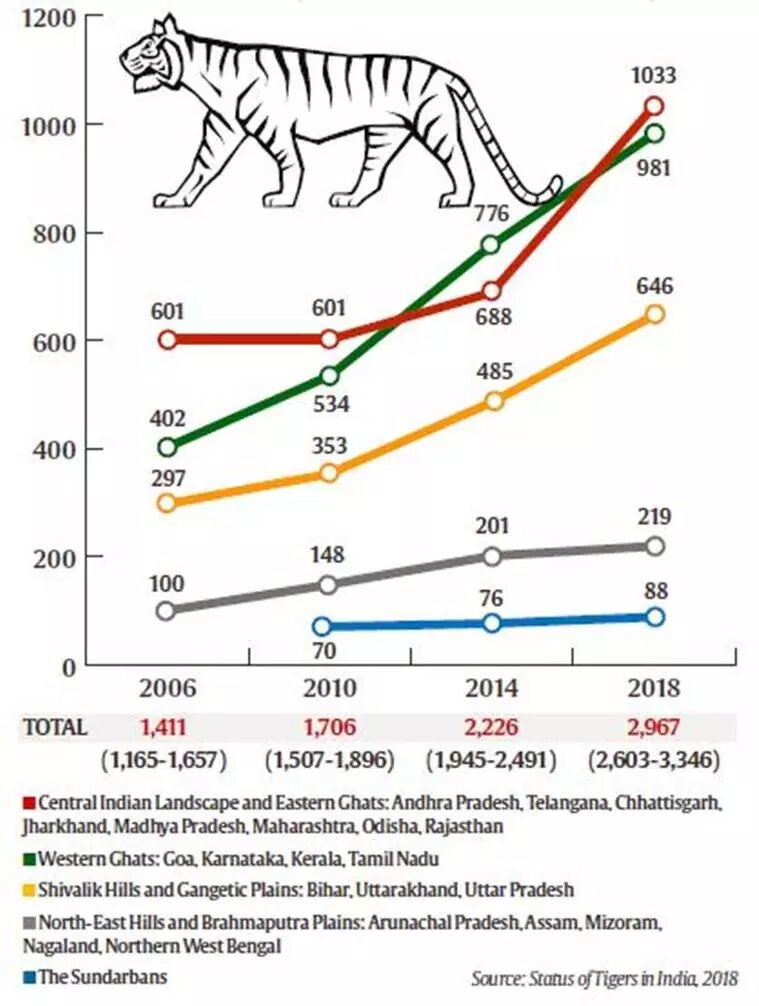
- Top Performers: Madhya Pradesh saw the highest number of tigers (526) followed by Karnataka (524) and Uttarakhand (442).
- Increase in Tiger population: Madhya Pradesh (71%) > Maharashtra (64%) > Karnataka (29%).
- Corbett Tiger Reserve in Uttarakhand has the highest number of tigers
- No tiger has been found in the Buxa (West Bengal), Palamau (Jharkhand), and Dampa (Mizoram) reserves.
Tiger Task Force
- The implementation of Project Tiger over the years has highlighted the need for a statutory authority with the legal backing to ensure tiger conservation.
- On the basis of the recommendations of the National Board for Wild Life, a Task Force was set up to look into the problems of tiger conservation in the country.
- The recommendations of the Task Force include strengthening Project Tiger by giving it statutory and administrative powers.
National Tiger Conservation Authority
- National Tiger Conservation Authority (NTCA) is a statutory body under the Ministry of Environment, Forests and Climate Change.
- It was established in 2005 following the recommendations of the Tiger Task Force.
- It was constituted under enabling provisions of the Wildlife (Protection) Act, 1972, as amended in 2006, for strengthening tiger conservation, as per powers and functions assigned to it.
Wildlife Institute of India (WII)
- Wildlife Institute of India (WII) offers training programs, academic courses, and advisory in wildlife research and management.
- Established in 1982.
- Established at Dehradun (winter capital and the most populous city in Uttarakhand).
- It is an autonomous Institution of the Ministry of Environment & Forests.
Steps Taken by the Government for Tiger Conservation
Legal Steps
- Amendment of the Wild Life (Protection) Act, 1972 to Wild Life (Protection) Act, 2006 for providing enabling provisions towards constituting the National Tiger Conservation Authority and the Tiger and Other Endangered Species Crime Control Bureau.
- Enhancement of punishment in cases of an offense relating to a tiger reserve or its core area.
Administrative Steps
- Strengthening of ant poaching activities, including special strategy for monsoon patrolling.
- State-level Steering Committees under the Chairmanship of Chief Ministers and establishment of Tiger Conservation Foundation.
- Creation of Special Tiger Protection Force (STPF) [Budget 2008]
Financial Steps
- Financial and technical help is provided to the States under various Centrally Sponsored Schemes, viz. Project Tiger and Integrated Development of Wildlife Habitats.
International Cooperation
- India has a bilateral understanding with Nepal on controlling transboundary illegal trade in wildlife
- India has signed a protocol on tiger conservation with China.
- India has signed a with Bangladesh for the conservation of the Royal Bengal Tiger.
- A sub-group on tiger/leopard conservation has been constituted for cooperation with the Russian Federation.
- A Global Tiger Forum of Tiger Range Countries has been created for addressing international issues related to tiger conservation.
- India is a party to CITES. CITES’ landmark decision states that ‘tigers should not be bred for trade in their parts and derivatives.
Conservation Assured | Tiger Standards (CA|TS)
- CA|TS is a set of criteria which allows tiger sites to check if their management will lead to successful tiger conservation.
- CA|TS is organised under seven pillars and 17 elements of critical management activity.
- CA|TS was developed by tiger and protected area experts.
- Officially launched in 2013, CA|TS is an important part of Tx2, the global goal to double wild tiger numbers by the year 2022.
- “The long-term goal of CA|TS is to ensure safe havens for tigers.”
- Out of total India’s Tiger reserves 14 have received the Conservation Assured Tiger Standards accreditation. The 14 tiger reserves which have been accredited are:
- Manas, Kaziranga and Orang in Assam,
- Satpura, Kanha and Panna in Madhya Pradesh,
- Pench in Maharashtra,
- Valmiki Tiger Reserve in Bihar,
- Dudhwa in Uttar Pradesh,
- Sunderbans in West Bengal,
- Parambikulam in Kerala,
- Bandipur Tiger Reserve of Karnataka and
- Mudumalai and Anamalai Tiger Reserve in Tamil Nadu
List of Tiger Reserves in India
| S.No. | Name of Tiger Reserve | State |
|---|---|---|
| 1 | Bandipur | Karnataka |
| 2 | Corbett | Uttarakhand |
| Amangarh (buffer of Corbett TR) | Uttar Pradesh | |
| 3 | Kanha | Madhya Pradesh |
| 4 | Manas | Assam |
| 5 | Melghat | Maharashtra |
| 6 | Palamau | Jharkhand |
| 7 | Ranthambore | Rajasthan |
| 8 | Similipal | Odisha |
| 9 | Sunderbans | West Bengal |
| 10 | Periyar | Kerala |
| 11 | Sariska | Rajasthan |
| 12 | Buxa | West Bengal |
| 13 | Indravati | Chhattisgarh |
| 14 | Namdapha | Arunachal Pradesh |
| 15 | Dudhwa | Uttar Pradesh |
| 16 | Kalakad-Mundanthurai | Tamil Nadu |
| 17 | Valmiki | Bihar |
| 18 | Pench | Madhya Pradesh |
| 19 | Tadoba-Andhari | Maharashtra |
| 20 | Bandhavgarh | Madhya Pradesh |
| 21 | Panna | Madhya Pradesh |
| 22 | Dampa | Mizoram |
| 23 | Bhadra | Karnataka |
| 24 | Pench | Maharashtra |
| 25 | Pakke | Arunachal Pradesh |
| 26 | Nameri | Assam |
| 27 | Satpura | Madhya Pradesh |
| 28 | Anamalai | Tamil Nadu |
| 29 | Udanti-Sitanadi | Chattisgarh |
| 30 | Satkosia | Odisha |
| 31 | Kaziranga | Assam |
| 32 | Achanakmar | Chattisgarh |
| 33 | Dandeli-Anshi | Karnataka |
| 34 | Sanjay-Dubri | Madhya Pradesh |
| 35 | Mudumalai | Tamil Nadu |
| 36 | Nagarahole | Karnataka |
| 37 | Parambikulam | Kerala |
| 38 | Sahyadri | Maharashtra |
| 39 | Biligiri Ranganatha Temple | Karnataka |
| 40 | Kawal | Telangana |
| 41 | Sathyamangalam | Tamil Nadu |
| 42 | Mukandra Hills | Rajasthan |
| 43 | Nawegaon-Nagzira | Maharashtra |
| 44 | Nagarjunsagar Srisailam | Andhra Pradesh |
| 45 | Amrabad | Telangana |
| 46 | Pilibhit | Uttar Pradesh |
| 47 | Bor | Maharashtra |
| 48 | Rajaji Tige Reserve | Uttarakhand |
| 49 | Orang Tiger Reserve | Assam |
| 50 | Kamlang Tiger Reserve | Arunachal Pradesh |
| 51 | Srivilliputhur-Megamalai Tiger Reserve | Tamil Nadu |
| 52 | Ramgarh Vishdhari TR | Rajasthan |
| 53 | Guru Ghasidas TR | Chhattisgarh |
| 54 | Ranipur Tiger Reserve | Uttar Pradesh |
State-wise National Parks, Tiger Reserves, Wildlife Sanctuaries and Ramsar Sites of India
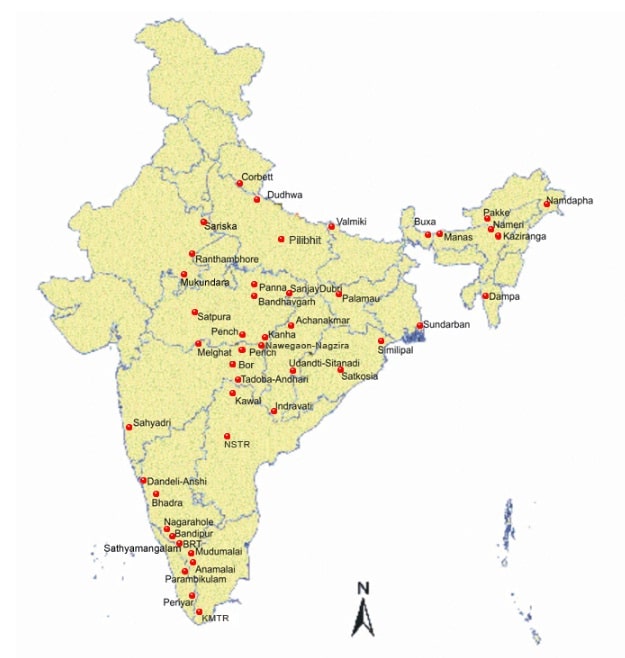
BR: Biosphere Reserve
NP: National Park
TR: Tiger Reserve.
WS/WLS: Wildlife Sanctuary
BS: Bird Sanctuary
PF: Protected Forest
RF: Reserve Forest
ER: Elephant Reserve
Tiger Reserves in India (with important details)
1. Kamlang, Arunachal
- Kamlang river
- Lohit district
- Tropical, Subtropical
- Tiger, leopard, clouded leopard, snow leopard
- Mishmi, Digaru, Mizo tribes
- It is separated from Namdapha by the Lang River
2. Namdapha, Arunachal
- Changlang district
- Biodiversity hotspots in Eastern Himalayas
- The fourth-largest national park of India
- Mishmi and Patkai Bum hills
- Evergreen, tropical, semi-tropical, temperate, arctic
- Tiger, leopard, clouded leopard, snow leopard
- Palearctic and Indo-Malayan biogeographic areas
- Namdapha Flying Squirrel which is endemic and critically endangered
- Dhole, red panda, marbled cat, fishing cat, binturong, takin, Bharal, serow, capped langur
3. Pakhui(Pakke), Arunachal
- East Kameng District
- Hornbill is found
- Kameng River
- Nameri National Park of Assam is nearby.
4. Kaziranga, Assam
- Golaghat, Karbi Angling and Nagaon districts
- Famous for Great One-horned rhinoceros
- Highest tiger density
- Elephants, wild water buffalo
- Brahmaputra river
- Elephant reserve, National park, Biodiversity hotspot
- It is not a biosphere reserve.
- Important bird area by Birdlife International
5. Manas, Assam
- TR, NP, BR, UNESCO World Heritage Site
- Royal Manas NP in Bhutan is contiguous
- Manas river flows through it which is a tributary of Brahmaputra river
- Assam roofed turtle, hispid hare, golden langur, pygmy hog, wild water buffalo
6. Nameri, Assam
- Sonitpur district of Assam
- Lies just south of Pakke Tiger Reserve of Arunachal Pradesh
7. Orang, Assam
- Brahmaputra river
- Darrang and Sonitpur district
- Indian Rhinoceros, Pygmy hog, Asian elephant, wild water buffalo, Bengal tiger
- It is the only stronghold of rhinoceros on the north bank of the Brahmaputra river.
8. Dampa, Mizoram
- Lushai Hills
9. Rajaji TR, Uttarakhand
- Shivaliks
- Named after C. Rajagopalchari
- Ganga and Song rivers
- Goral is found here
- Asian elephant, Bengal tiger, Leopard, Jungle cat, striped hyena, Goral
10. Corbett , Uttarakhand
- Oldest NP of India, created in 1936
- Earlier called Hailey National Park
- Nainital and Pauli Garhwal districts
- Ramganga river
- The first national park of Asia
- Spotted dear, sambar deer, elephant, tawny fish owl, golden jackal
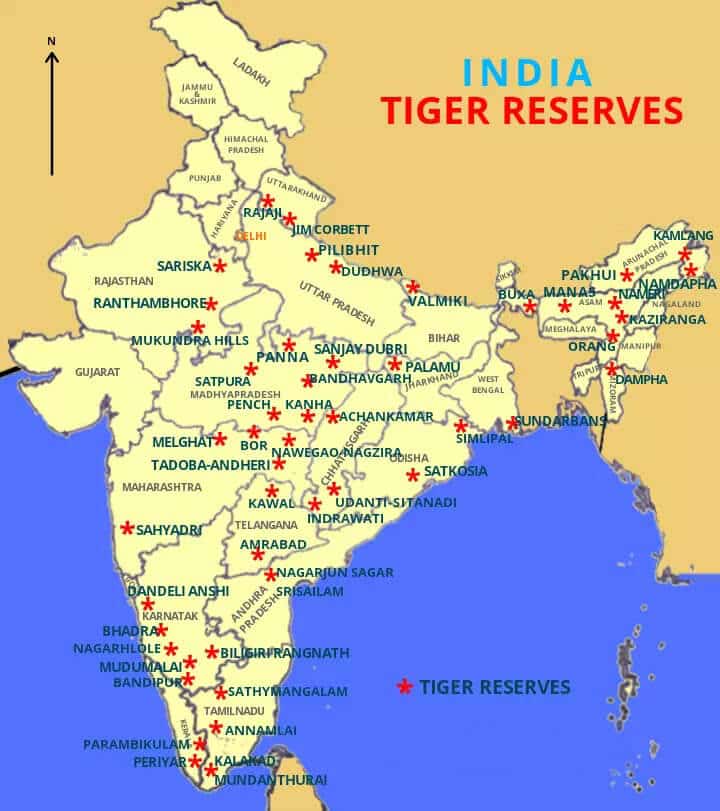
11. Dudhawa, UP
- Billy Arjan Singh – famous for conservation of Tiger
- In the Terai belt of marshy grasslands of (Lakhimpur Kheri district) northern Uttar Pradesh.
- Swamp deer, Sambar deer, barking deer, spotted deer, hog deer, sloth beer, ratel, jackal, civets, jungle cats, fishing cat, leopard cat.
- It is the only place in U.P. where both Tigers and Rhinos can be spotted together.
- It comprises of:
- Dudhwa National Park through which Suheli and Mohana streams flow,
- Kishanpur Wildlife Sanctuary through which Sharda River flows, and
- Katarniaghat Wildlife Sanctuary through which Geruwa River flows.
- All of these rivers are tributaries of the Ghagra River.
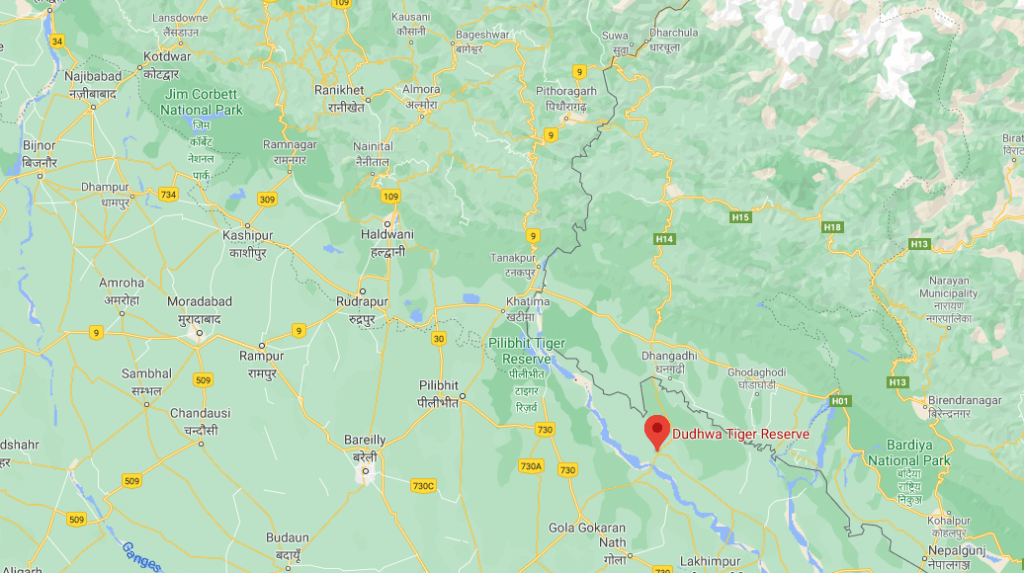
12. Pilibhit, UP
- Pilibhit, Lakhimpur Kheri, Bahraich districts
- In 2020, it bagged the international award Tx2 for doubling up the number of tigers in the past four years.
- River Sharada( Mahakali), River Ghagara
- It forms the part of Terai Arc Landscape in the upper Gangetic Plain.
- The northern edge of the reserve lies along the Indo-Nepal border while the southern boundary is marked by the river Sharada and Khakra.
- Wild animals include tiger, swamp deer, Bengal florican, leopard, etc.
- It has high sal forests, plantations, and grasslands with several water bodies.

13. Valmiki , Bihar
- West Champaran district
- Royal Chitwan national park of Nepal is contiguous
- River Gandak
- Barking deer, spotted deer, hog deer, sambar, blue bull, spotted hyena, leopard cat, wild cat, fishing cat, flying squirrel, clouded leopard, Indian gaur, Mongoose
14. Palamu TR, Jharkhand
- Betla NP and Palamu WS
- Naxal affected
- One among the original 9 tiger reserves
- North Koel river
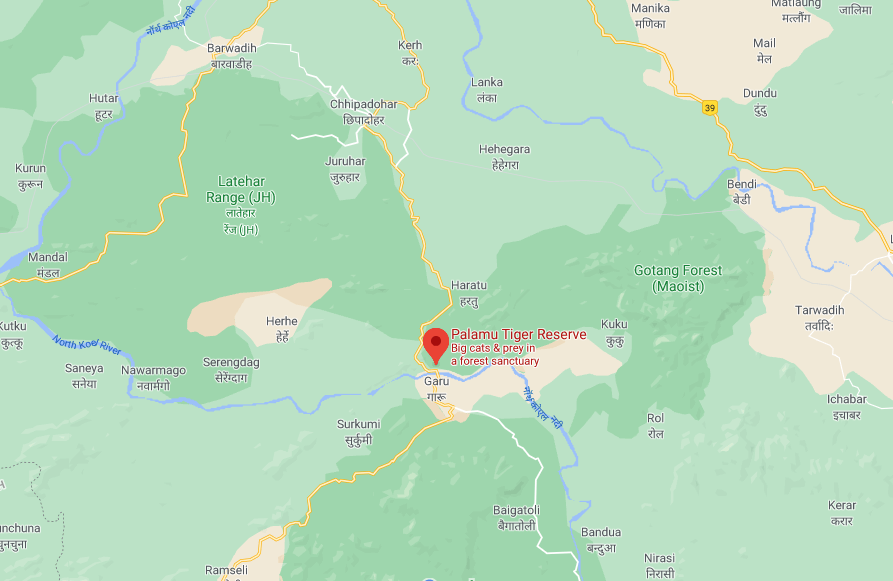
15. Sunderbans, WB
- NP, TR, BR
- Ganges river
- Mangrove-ecotone
- Sundarbans mangrove forest, one of the largest such forests in the world lies across India and Bangladesh on the delta of the Ganges, Brahmaputra, and Meghna rivers on the Bay of Bengal.
- Saltwater crocodile
- Recently declared Ramsar site
- UNESCO World Heritage site
- It is home to many rare and globally threatened wildlife species such as the estuarine crocodile, Royal Bengal Tiger, Water monitor lizard, Gangetic dolphin, and olive ridley turtles.
16. Buxa, WB
- North part of WB
- Near Manas TR
- Asian elephant, gaur, sambar deer, clouded leopard, Indian leopard, Bengal tiger
17. Simlipal, Odissa
- Mayurbhanj district
- Red silk-cotton trees
- World Network of Biosphere Reserves
- 12 small rivers are there
- ER
- Bengal tiger, Asian elephant, gaur, chausingha
18. Satkosia, Odissa
- Satkosia TR, Bhubaneswar comprises two adjoining sanctuaries of central Odisha named as Satkosia Gorge Sanctuary and Baisipalli Sanctuary.
- Mahanadi river
- Slightly southward of Simlipal TR
- Lying in a transitional zone extending between the Chhota Nagpur Plateau and the Deccan Plateau, the tiger reserve exhibits endemic life forms of both biotic provinces.
- The area supports moist deciduous forest, dry deciduous forest, and moist peninsular Sal forest.
- This area is the home for Tiger, Leopard, Elephant, Gaur, Chousingha, Sloth bear, Wild dog, varieties of resident and migratory birds, reptilian species, etc.
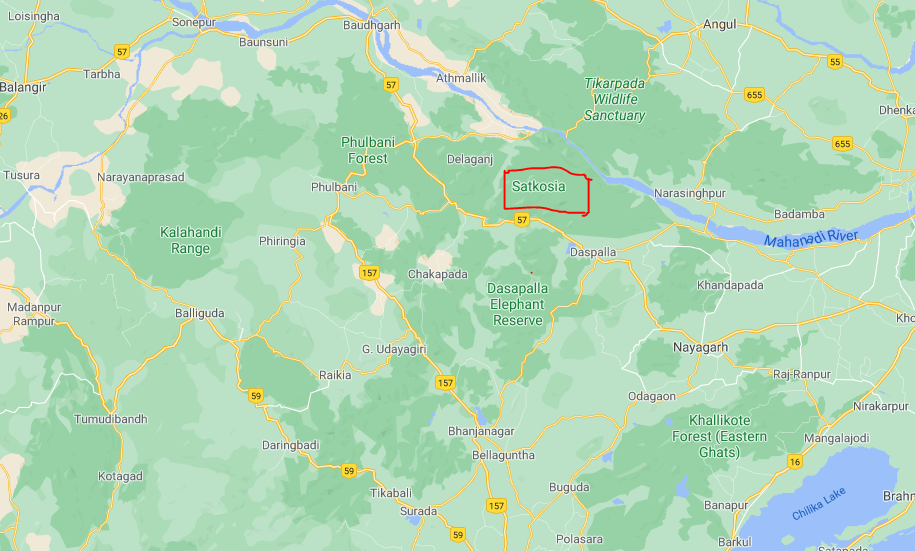
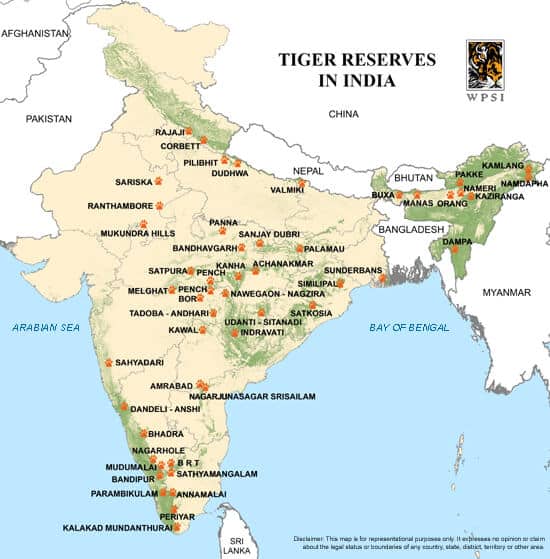
19. Ranthambore, Rajasthan
- Sawai Man Singh Sanctuary and Keladevi Sanctuary
- Indian leopard, Nilgai, Wild boar, Sambar, Striped hyena, Sloth bear
- Banas and Chambal rivers
- The forest type is mainly tropical dry deciduous with ‘dhak’ (Butea monsoperma),a species of tree capable of withstanding long periods of drought, being the commonest.
- This tree is also called as ‘Flame of forest’ and is one of the many flowering plants that add colour to the dry summers here.
20. Sariska, Rajasthan
- Sariska Tiger Reserve is located in Aravali hills and forms a part of the Alwar District of Rajasthan.
- Copper and marble mining
- Indian leopard, jungle cat, caracal, striped hyena, golden jackal, chital, sambar deer, nilgai
- All tigers in Sariska became extinct in 2005.
- The Sanctuary houses ruined temples, forts, pavilions, and a palace.
- Kankarwadi fort is located in the center of the Reserve and it is said that Mughal emperor Aurangzeb had imprisoned his brother Dara Shikoh at this fort in the struggle for succession to the throne.
- The Reserve also houses a famous temple of Lord Hanuman at Pandupole related to Pandavas.
21. Mukundra Hills, Rajasthan
- The park is situated in a valley formed by two parallel mountains viz. Mukundra and Gargola.
- Darrah, Chambal and Jawahar Sagar WSs
- The 4 rivers (Ramzan, Ahu, Kali, and Chambal) form the boundary of the valley.
- It is located on the eastern bank of the Chambal River and is drained by its tributaries.
- It was considered for the introduction of the Asiatic lion.
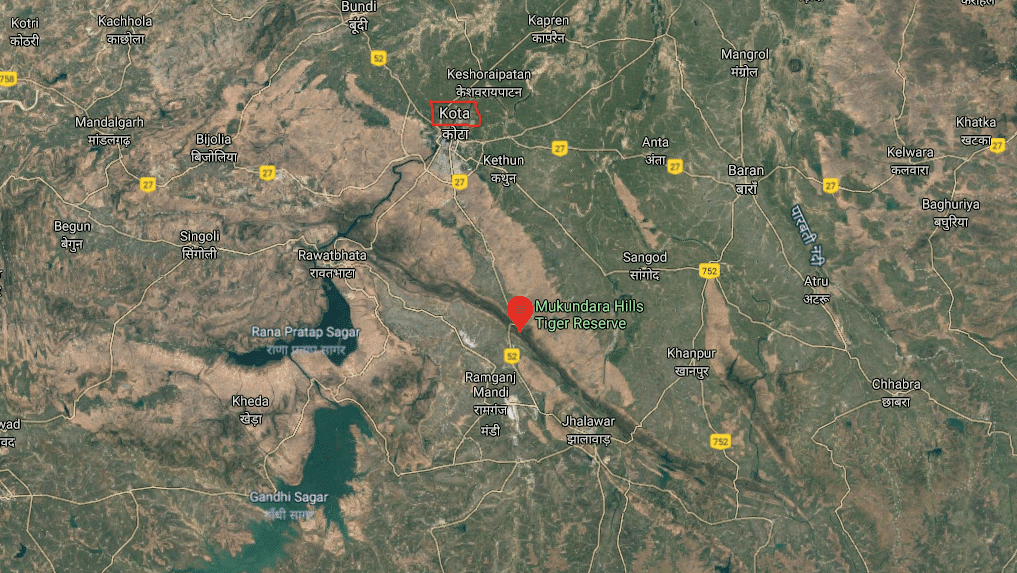
22. Achanmakar, Chattisgarh
- Mungeli district
- Achanmakar- Amarkantak BR
- Indian leopard, gaur, chital, striped hyena, Indian jackal , sloth bear
23. Udanti-Sitanadi, Chattisgarh
- Udanti and Sitanadi Was
- Sitanadi river
24. Indravati, Chattisgarh
- Indravati river
- Wild Asian buffalo, Nilgai, Blackbuck, Chowsingha, sambar, chital, Indian muntjac, tiger, leopard, sloth bear, dholes
25. Panna, MP
- Will be submerged because of Ken-Betwa interlinking
- Ken river passes through it
- 2012 – tiger extinction
- Chital, chinkara, nilgai, sambar, sloth bear
26. Bandhavgarh, MP
- Umaria district
- White tiger used to be found
- Sambar, barking deer, nilgai, caracal, striped hyena, Indian wolf
27. Sanjay-Dhubri, MP
- Some part is in Chattisgarh (Guru Ghasidas NP)
- Bengal tiger, the Indian Leopard, spotted deer, sambar deer, wild boar, nilgai, chinkara, civet, porcupine
28. Kanha, MP
- also called Kanha-Kisli National Park
- Largest NP of Madhya Pradesh
- Royal Bengal Tiger, Indian leopards, Sloth Bear, Barasingha, Indian wild Dog
- The forest is depicted in Rudyard Kipling’s Jungle Book
- First TR to have a mascot– Bhoorsingh, the Barasingha
29. Satpura, MP
- Satpura Range
- Indian bison, tigers, Dholes, Blackbuck, Porcupine,Sambar,Barasingha, Flying Squirrels
- Mahuva tree in its buffer zone
- located south of Narmada River.
- Denwa river is the main water source of the park.
30. Pench, MP
- Both in MP and Maharastra
- Southern slopes of Satpura
- Pench river
- Chital,Sambar, Gaur, Nilgai, Wild pig, Indian muntjac, Chowsingha
31. Nawagaon-Nagzira, Maharastra
- Nawagaon means new village
- Dr. Salim Ali Bird Sanctuary
- Gondia district
- Formed out of 2 WSs
32. Pench, Maharastra
- Also in MP
- Pench river flows right through the middle of the park.
- Pench Tiger Reserve is located in the southern reaches of the Satpura hills.
- Mammals: Sloth bear, jackal, nilgai, wild dog
- Birds: Peafowl, magpie robin, pintail, drongo, unia, myna, etc.
33. Bor TR, Maharastra
- Wardha district
- Bor Dam
34. Tadoba- Andhari, Maharastra
- Tadoba NP and Andhari WS
- Maharastra’s oldest and largest NP
- Chandrapura district
- Andhari river
35. Sahyadari, Maharastra
- Westernmost TR of India
36. Melghat, Maharastra
- Among the first 9 TR
- Amravati district
- Satpura range
- Tapti river
- Bengal tiger, Indian leopard, Sloth bear, Indian jackal, sambar, gaur, barking deer, nilgai, cheetal
37. NagarjunaSrisailam
- Found both in AP and Telangana
- Nallamalla hills
- Krishna river
- Largest TR of India
38. Amrabad, Telangana
- Lies in the Nallamala Hills of Telangana.
- It is India’s second-largest tiger reserve, next only to Nagarjunasagar Srisailam Tiger Reserve (Andhra Pradesh and Telangana).
- It has a large presence of the Chenchu tribe.
39. Kawal TR, Telanghana
- Godavari and Kadam rivers
40. Parambikulam, Kerala
- Palakkad district
- Anamalai hills
- Lion-tailed macaque, Nilgiri Tahr, Elephants, Bengal tigers,Indian leopards, Wild boar, Sambar, Travancore Flying Squirrel
41. Periyar, Kerala
- Sabrimala temple
- TR, ER
- Periyar and Pamba rivers
- Cardamom hills and Pandalam hills
- Mullaperiyar dam
- Six tribal communities nestled inside the reserve such as Mannans, Paliyans, Malayarayans, Mala Pandarams, Uralis, and Ulladans.
- Tiger, Elephant, Lion-tailed macaque, Nilgiri Tahr, etc.
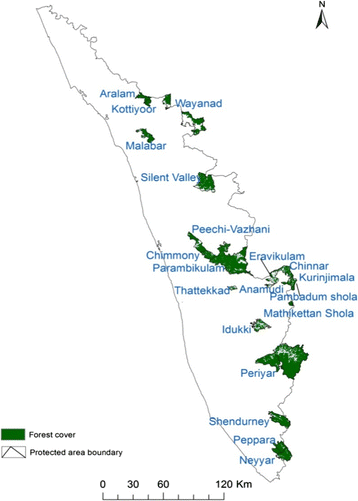
42. Sathyamangalam, TN
- Erode district
- Wildlife corridor in Nilgiri between Western Ghat and Eastern Ghat
43. Mudumalai, TN
- Nilgiri hills
- Indian elephant, Bengal tiger, Gaur, Indian leopard
44. Anamalai, TN
- Anamalai hills
- Indira Gandhi WS and NP
- Also called Topslip
45. Kalakad- Mundathurai TR, TN
- Western Ghats
- Part of Agasthyamalai BR
- Southernmost TR
46. Dandeli- Anshi, Karnataka
- Uttara Kannada district
- Bengal tigers, Black panthers, Indian elephants
- Kali river
- Western Ghat
47. Bhadra, Karnataka
- Bhadra river
- Bada Budan Giri range
48. Nagarhole, Karnataka
- It is also known as Rajiv Gandhi National Park.
- Kodagu and Mysore district
- The Park lies in the Western Ghats and is a part of the Nilgiri Biosphere Reserve.
- Tiger, Gaur, Elephant, Indian Leopard, Deer
- Brahmagiri hills
- Kabini reservoir separates Bandipore and Nagarhole
- Nagarahole River flows through the park, which joins the Kabini River which also is a boundary between Nagarahole and Bandipur National Park.
49. Bandipore, Karnataka
- Kabini river in north and Moyar river in the south.
- Nugu river runs through the park
- Night traffic ban
- Lantana lace used to remove Lantana weed
- Indian elephants, Gaurs, tigers, sloth bears, muggers, Indian rock pythons, Four-horned antelopes, jackals, dholes
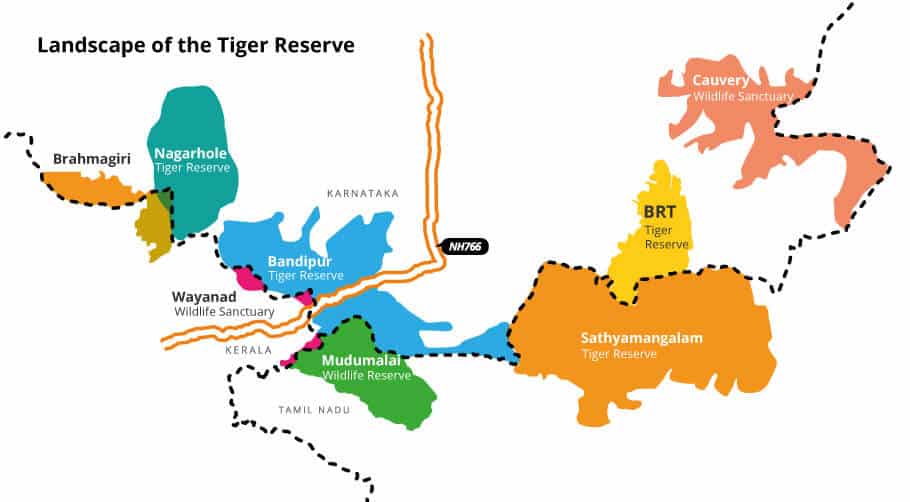
50. BRT, Karnataka
- Biligiri Rangana Hills
- Biligiri Rangana Swamy Temple WS
- Connects Eastern and the Western Ghats
51. Srivilliputhur-Megamalai TR, Tamil Nadu
- The Srivilliputhur Megamalai Tiger Reserve will span the forests of Megamalai wildlife sanctuary and Srivilliputhur grizzled squirrel wildlife sanctuary.
- Srivilluputhur hosts leopards, Nilgiri tahrs, Lion tailed macaques, jungle cats, and sambars.
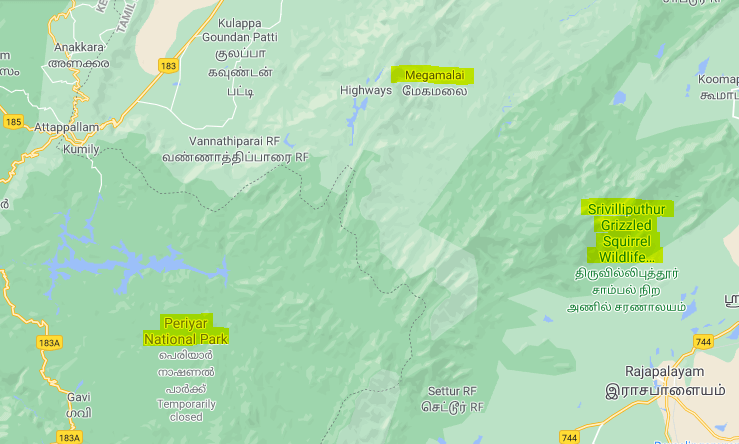
52. Ramgarh Vishdhari TR, Rajasthan
- Ramgarh Vishdhari wildlife sanctuary is located at a distance of 45 Km from Bundi City on Bundi-Nainwa Road near Village Ramgarh, District Bundi, Rajasthan.
- It was notified in the Year 1982.
- Ramgarh Vishdhari WLS acts as a buffer for Ranthambore National Park.
- The sanctuary is covered with deciduous forests.
- Its flora consists of Dhok, Khair, Salar, Khirni trees with some Mango and Ber trees.
- The Fauna consists of birds and animals like Leopard, Sambhar, Wild boar, Chinkara, Sloth bear, Indian Wolf, Hyena, Jackal, Fox, deer, and Crocodile.
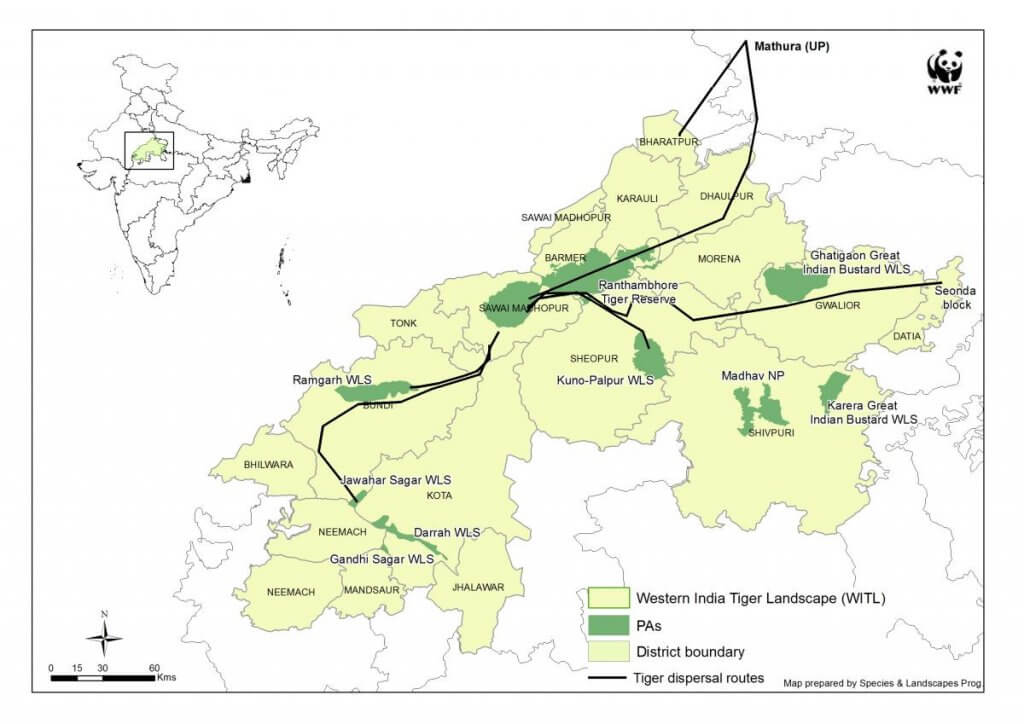
53. Guru Ghasidas TR, Chhattisgarh
- National Tiger Conservation Authority (NTCA) has designated the combined areas of the Guru Ghasidas National Park (Sanjay National Park) and Tamor Pingla Wildlife Sanctuary as a Tiger Reserve.
- It is located in the northern part of Chhattisgarh, bordering Madhya Pradesh and Jharkhand.
- This will be the fourth Tiger Reserve in Chhattisgarh, after the Udanti-Sitanadi, Achanakmar, and Indravati Reserves.
- Guru Ghasidas National Park was the last known habitat of the Asiatic cheetah in the country.
- It connects Jharkhand and Madhya Pradesh and provides a corridor for tigers to move between the Bandhavgarh (Madhya Pradesh) and Palamau Tiger Reserves (Jharkhand).
- Flora: The vegetation consists mainly of mixed deciduous forest with teak, sal and bamboo trees.
- Fauna: Tiger, Leopard, Chital, Nilgai, Chinkara, Jackal, Sambar, Four-horned Antelope etc.
- Tamor Pingla Wildlife Sanctuary
- It is located in the Surajpur district of Chhattisgarh bordering Uttar Pradesh. It is named after Tamor hill and Pingla Nalla.
- Tamor hill and Pingla Nalla are considered to be the old and prominent features of the sanctuary area.
- Mixed deciduous forests dominate the sanctuary. Sal and bamboo forests are seen all through.
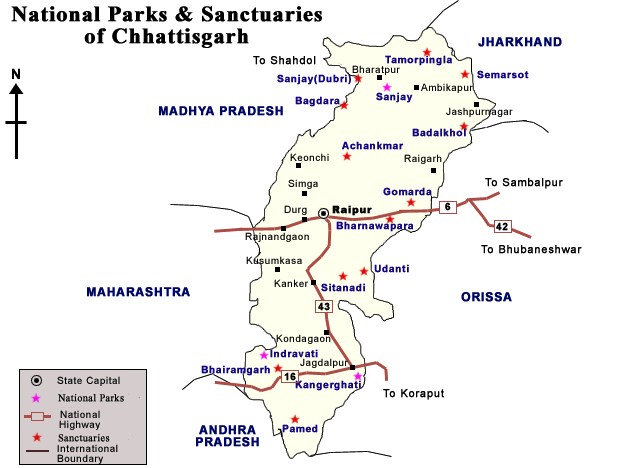
54. Ranipur Tiger Reserve
- Ranipur Wildlife Sanctuary (RWS) founded in 1977, has no resident tiger. However, it is an important corridor for the movement of tigers, according to the Status of tigers, co-predators and prey in India report by the National Tiger Conservation Authority (NTCA).
- The Ranipur Tiger Reserve will be the fourth in UP.
- It will also be the first in the Bundelkhand region of the state.
- Flora: There is dry deciduous forest of Bamboo, Palash, Khair, Mahua, Dhau, Saal, Tendu, etc.
- Fauna: Blackduck, Chinkara, Sambar, Cheetal, Bear, Leopard, Wolf, Wild dog, Blue bull, etc.
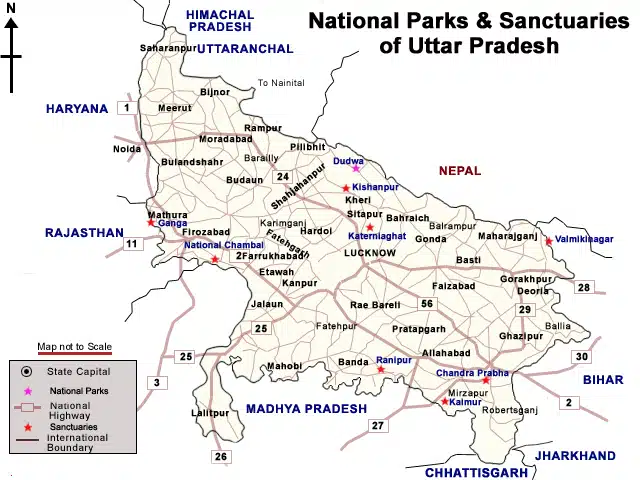
Tiger Relocation Project
- India’s first inter-state tiger translocation project was initiated in 2018 wherein two big cats, a male (Mahavir) from Kanha Tiger Reserve and a female (Sundari) from Bandhavgarh from Madhya Pradesh were relocated to Satkosia Tiger Reserve in Odisha, to shore up the tiger population in the state.
- The relocation was meant to serve two purposes:
- reducing the tiger population in areas with excess tigers to majorly reduce territorial disputes
- reintroduce tigers in areas where the population has considerably reduced due to various reasons
- The project ran into trouble within weeks of initiation, and the project was suspended by NTCA. A major reason for the failure was the lack of confidence and trust-building between the forest department and the villagers.
KAZI 106F [Golden Tiger]
- ‘Kazi 106F’, described as the country’s only Golden Tiger.
- Kazi 106 F, the tigress, resides in the world heritage Kaziranga National Park of Assam. It is also known as ‘Tabby tiger’ or ‘Strawberry tiger’.
- The skin of tigers is orange-yellow with black stripes and a whitish abdominal region.
- The yellowish background is controlled by a set of ‘agouti genes’ and their alleles and the black colour stripes are controlled by ‘tabby genes’ and their alleles. Suppression of any of these genes may lead to colour variation in tigers.
- Agouti genes interact with the pigment cells to produce yellow to red or brown to black expression. This interaction is responsible for making distinct light and dark bands in the hairs of animals such as the agouti here same is happening in our tigress – Kazi 106 F.

Great….. Fantastic Article
Such a great collection of information I have no words please my request to you please guide us regularly and provide such kind of information in future ……this is a huge sets of collections
Thanks, Mahesh for your kind words. Keep Reading.
Great information 👌👌
How to download this note
best notes for all govt exams , specially for upsc, thanks a lot.
Guru Ghasidas NP is yet to receive TR approval.
54th TR is Dholpur-Karauli Tiger Reserve .
Great efforts from @LotusArise ..thanks alot
I am totally confused that what is the 53 rd and 54th tiger reserve. Some sites says:- Ranipur tiger reserve, some says Dholpur tiger reserve, and some says guru ghansidaas tiger reserve ? 🙆🙍